
Hydropower, also known as water power, is the use of falling or fast-running water to produce electricity or to power machines. This is achieved by converting the gravitational potential or kinetic energy of a water source to produce power. Hydropower is a method of sustainable energy production. Hydropower is now used principally for hydroelectric power generation, and is also applied as one half of an energy storage system known as pumped-storage hydroelectricity.

Small hydro is the development of hydroelectric power on a scale suitable for local community and industry, or to contribute to distributed generation in a regional electricity grid. Exact definitions vary, but a "small hydro" project is less than 50 megawatts (MW), and can be further subdivide by scale into "mini" (<1MW), "micro" (<100 kW), "pico" (<10 kW). In contrast many hydroelectric projects are of enormous size, such as the generating plant at the Three Gorges Dam at 22,500 megawatts or the vast multiple projects of the Tennessee Valley Authority.

Hydroelectricity, or hydroelectric power, is electricity generated from hydropower. Hydropower supplies one sixth of the world's electricity, almost 4,500 TWh in 2020, which is more than all other renewable sources combined and also more than nuclear power. Hydropower can provide large amounts of low-carbon electricity on demand, making it a key element for creating secure and clean electricity supply systems. A hydroelectric power station that has a dam and reservoir is a flexible source, since the amount of electricity produced can be increased or decreased in seconds or minutes in response to varying electricity demand. Once a hydroelectric complex is constructed, it produces no direct waste, and almost always emits considerably less greenhouse gas than fossil fuel-powered energy plants. However, when constructed in lowland rainforest areas, where part of the forest is inundated, substantial amounts of greenhouse gases may be emitted.
Longtan Dam is a large roller-compacted concrete (RCC) gravity dam on the Hongshui River in Tian'e County of the Guangxi Zhuang Autonomous Region, China, a tributary of the Xi River and the Pearl River. The dam is 216.2 metres (709.3 ft) high and 849 m (2,785 ft) long; it is the tallest of its type in the world. The dam is intended for hydroelectric power production, flood control and navigation. The dam contains seven surface spillways, two bottom outlets and an underground power station. The Longtan ship lift, part of the dam complex, will be the tallest ship lift system in the world.
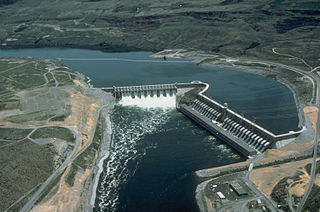
Run-of-river hydroelectricity (ROR) or run-of-the-river hydroelectricity is a type of hydroelectric generation plant whereby little or no water storage is provided. Run-of-the-river power plants may have no water storage at all or a limited amount of storage, in which case the storage reservoir is referred to as pondage. A plant without pondage is subject to seasonal river flows, so the plant will operate as an intermittent energy source. Conventional hydro uses reservoirs, which regulate water for flood control, dispatchable electrical power, and the provision of fresh water for agriculture.

Nuozhadu Dam is an embankment dam on the Lancang (Mekong) River in Yunnan Province in southwest China. The dam is 261.5 m (858 ft) tall, and creates a reservoir with a normal capacity of 21,749,000,000 m3 (17,632,000 acre⋅ft) at a level of 812 m (2,664 ft) asl. The purpose of the dam is hydroelectric power production along with flood control and navigation. The dam supports a power station with nine generators, each with generating capacity of 650 MW. The total generating capacity of the power station is 5,850 MW. Construction on the project began in 2004; the dam's first generator went online 6 September 2012 and the last generator was commissioned in June 2014. The construction and management of the project was implemented by Huaneng Power International Ltd., which has a concession to build, own and operate hydroelectric dams on China's stretch of the Mekong River.
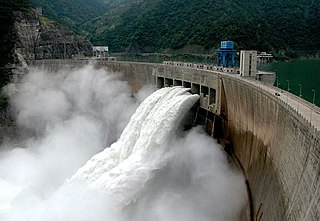
The Ertan Dam is an arch dam on the Yalong River, a tributary of the Yangtze River in Sichuan Province, in southwest China.
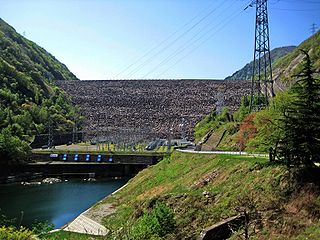
Miboro Dam is a dam on the Shō River in Shirakawa, in Gifu Prefecture Japan. It supports a 256 MW hydroelectric power station. Of the nine dams on the Shō River, it is the furthest upstream.

The Rama Dam is a concrete-face rock-fill dam on the Rama river, a tributary of the Neretva river, about 4 km (2.5 mi) southwest of the town of Prozor in the Herzegovina-Neretva Canton of Bosnia and Herzegovina.
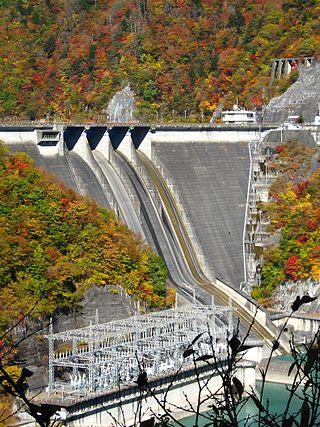
The Hatanagi-I is a dam on the Ōi River in Aoi-ku, Shizuoka, Shizuoka Prefecture on the island of Honshū, Japan. With a height of 125 metres (410 ft), it is the tallest hollow-core concrete gravity dam in the world. It has a hydroelectric power generating station owned by the Chubu Electric Power Company. It supports a 137 megawatts (184,000 hp) pumped-storage hydroelectric power station.
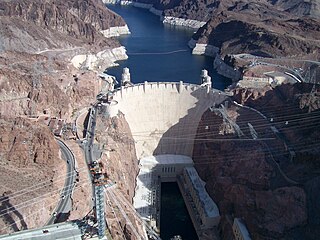
Hydroelectricity is, as of 2019, the second-largest renewable source of energy in both generation and nominal capacity in the United States. In 2021, hydroelectric power produced 31.5% of the total renewable electricity, and 6.3% of the total U.S. electricity.
The Shuibuya Dam is a concrete-face rock-fill embankment dam on the Qingjiang River in Badong County, Enshi, Hubei Province, China. The purpose of the dam is mainly hydroelectricity but it also promotes flood control, navigation, tourism and fishery. At 233 m (764 ft) tall and containing 15,640,000 m3 (20,460,000 cu yd) of material, it is the tallest concrete face rock-fill dam in the world.

The Yeywa Hydropower Station, located on the Myitnge River, 52 kilometres (32 mi) southeast of Mandalay city, at Yeywa village in Kyaukse Township, Mandalay Region in central Myanmar, is the country's first roller-compacted concrete (RCC) dam, and the site of a 790-megawatt (1,060,000 hp) hydroelectric power plant, the largest in the country.

The Longyangxia Dam is a concrete arch-gravity dam at the entrance of the Longyangxia canyon on the Yellow River in Gonghe County, Qinghai Province, China. The dam is 178 metres (584 ft) tall and was built for the purposes of hydroelectric power generation, irrigation, ice control and flood control. The dam supports a 1,280 MW power station with 4 x 320 MW generators that can operate at a maximum capacity of 1400 MW. Controlling ice, the dam controls downstream releases to reservoirs lower in the river, allowing them to generate more power instead of mitigating ice. Water in the dam's 24.7 billion m3 reservoir provides irrigation water for up to 1,000,000 hectares of land.
The Jishixia Dam is a concrete face rock-fill embankment dam on the Yellow River in Qinghai Province, China. It is 101 m (331 ft) tall and downstream from the Gongboxia Dam. The purpose of the dam is hydroelectric power generation and flood control. The dam supports a power station with 3 x 340 MW Francis turbines for a total installed capacity of 1,020 MW. Construction on the dam began in 2005 and the river was diverted in March 2007. The first generator was operational in mid-2010 and the rest by the end of the year.
The Jinping-I Dam also known as the Jinping-I Hydropower Station or Jinping 1st Cascade, is a tall arch dam on the Jinping Bend of the Yalong River in Liangshan, Sichuan, China. Construction on the project began in 2005 and was completed in 2014. Its power station has a 3,600 MW capacity to produce between 16 and 18 TW·h annually. Supplying the power station is a reservoir created by the 305-meter-tall arch dam, the tallest in the world. The project's objective is to supply energy for expanding industrialization and urbanization, improve flood protection, and prevent erosion.

The Okutadami Dam (奥只見ダム) is a concrete gravity dam on the Tadami River, 26 km (16 mi) east of Uonuma on the border of Niigata and Fukushima Prefectures, Japan. The primary purpose of the dam is hydroelectric power generation and it supports a 560 MW power station which is the largest conventional hydroelectric power station in Japan. The dam also forms the second largest reservoir in Japan, next to that of the Tokuyama Dam.

The Otori Dam is a concrete arch-gravity dam on the Tadami River, 17 km (11 mi) southwest of Tadami in Fukushima Prefecture, Japan. The primary purpose of the dam is hydroelectric power generation and it supports a 182 MW power station. The power station contains two Kaplan turbine-generators. Unit 1 was commissioned on 20 November 1963 while Unit 2 was commissioned on 7 June 2003 as part of a power plant expansion project that included an additional 200 MW generator at Okutadami Dam upstream. The dam is 83 m (272 ft) tall and 188 m (617 ft) long. Its reservoir has a 15,800,000 m3 (12,809 acre⋅ft) capacity of which 5,000,000 m3 (4,054 acre⋅ft) is active for power generation. The reservoir has a catchment area of 656.9 km2 (254 sq mi) and surface area of 89 ha. Of the two generators, Unit 1 has a maximum effective hydraulic head of 50.8 m (167 ft) and Unit 2 is afforded 48.1 m (158 ft). The design flood discharge of the dam is 2,200 m3/s (77,692 cu ft/s) and its service spillway is controlled by three tainter gates.
Winder Dam is a proposed small, low-head, earth core rockfill, hydroelectric power generation dam of 0.3 megawatt (MW) generation capacity, located across Winder River about 100 km from Karachi in Lasbela District, Balochistan province of Pakistan.

Hydroelectricity is currently China's largest renewable energy source and the second overall after coal. According to the International Hydropower Association, China is the worlds largest producer of hydroelectricity as of 2021. China's installed hydroelectric capacity in 2021 was 390.9 GW, including 36.4 GW of pumped storage hydroelectricity capacity, up from 233 GW in 2011. That year, hydropower generated 1,300 TWh of power, an increase of 68 TWh over 2018 when hydropower generated 1,232 TWh of power, accounting for roughly 18% of China's total electricity generation.















